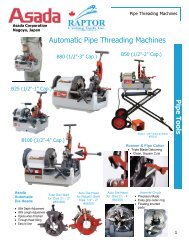CMX 2004 - Plumbing & HVAC
CMX 2004 - Plumbing & HVAC
CMX 2004 - Plumbing & HVAC
Create successful ePaper yourself
Turn your PDF publications into a flip-book with our unique Google optimized e-Paper software.
Trucks for the Trade<br />
Truck Graphics, Part II<br />
Choose the right graphic designer<br />
There is more to graphics than<br />
putting stickers on a truck<br />
By Simon Blake<br />
In Part 1 of this article (Jan/Feb., <strong>2004</strong>), we talked about<br />
what goes into effective truck graphics. In Part II, we look<br />
at choosing a graphics supplier and the practical aspects<br />
of applying graphics to a truck.<br />
The graphics that a contractor<br />
applies, or doesn’t apply, to his<br />
truck become the company’s identity<br />
in the community. This makes<br />
choosing a graphic designer and deciding<br />
on graphics one of the most important<br />
decisions that a company owner –<br />
and it should be the owner – will make.<br />
“Many contractors fail by delegating<br />
the development of truck graphics and<br />
other promotional material to an employee,”<br />
notes Gordon McCallum, creative<br />
director for McCallum Graphics in<br />
Mississauga, Ont. Truck graphics should<br />
be part of a total marketing campaign. It<br />
is therefore important to choose a<br />
graphic designer that understands the<br />
company’s overall goals, he added.<br />
Just as a customer does when hiring a<br />
service contractor, a contractor should<br />
ask to see previous work, check references<br />
and talk to other contractors when<br />
commissioning graphics for his truck(s).<br />
The process is easier where the<br />
graphics company does its design work<br />
in-house, reports Julian Sarboiu of<br />
AXXENT Signs Inc. in Mississauga,<br />
Ont. Working with one company on the<br />
Beware of<br />
copyright<br />
Any contractor that wants to use<br />
something previously published<br />
elsewhere, such as a comic book<br />
or cartoon character, MUST obtain<br />
permission from the individual or<br />
company that owns the copyright.<br />
Calgary contractor Peter<br />
Archdekin, president of Pete the<br />
Plumber, actually phoned Marvel<br />
Comics to check the rules concerning<br />
the use of their superhero<br />
figures on his trucks. He was told<br />
the company could ask him to<br />
remove the characters, but as long<br />
as he didn’t use any individual<br />
character on more than one truck<br />
and because he was “a little guy<br />
up in Canada,” they probably<br />
wouldn’t bother.<br />
design and another to apply it to the truck<br />
can add cost, downtime and headaches.<br />
One other thing to keep in mind<br />
when hiring a graphics supplier is how<br />
long they intend to keep the truck.<br />
Because the design work is done on<br />
computer, there is no need for the truck<br />
to be at a graphics shop until the graphics<br />
are actually ready to be applied. A<br />
two-day turnaround is typical, advises<br />
Sarboiu. “Shy away from shops that<br />
cannot provide you with a specific<br />
timeline for your job’s completion.”<br />
The shop should also have valid liability<br />
and contents insurance that covers<br />
your truck while it is in their hands,<br />
he added.<br />
How it’s done<br />
Digital photography and computerized<br />
graphic design software have made the<br />
process of creating custom graphics for<br />
a truck relatively straightforward.<br />
Typically, the designer will work out<br />
the graphics with the contractor on a<br />
computer screen using a file graphic of<br />
the particular model of truck. “It should<br />
not be a complicated process from the<br />
customer’s point of view,” notes<br />
Sarboiu.<br />
Once the design is done, the artist<br />
will print or e-mail a ‘photo’ of the completed<br />
truck. That can be changed and<br />
adjusted until the contractor is satisfied<br />
with the result. Only then are the fullsized<br />
graphics produced.<br />
Today most truck graphics are done<br />
in vinyl. An enormous range of colours<br />
and special effects are available. “There<br />
are certain things that you can incorporate<br />
into graphics today that don’t cost a<br />
lot more money but have benefit –<br />
reflective graphics, for example. They<br />
light up when headlights hit them,”<br />
notes McCallum. Exploring options<br />
with several graphic designers can be<br />
time well spent.<br />
There are two methods of printing<br />
graphics – inkjet that prints the image<br />
onto the vinyl and thermal imaging,<br />
which fuses the ink to the vinyl with<br />
heat. Thermal imaging is generally considered<br />
more durable. However, some<br />
shops warranty inkjet work for five years.<br />
The vinyl itself comes in a number<br />
of different qualities – everything<br />
from extremely expensive material<br />
that will outlive the truck to cheaply<br />
Today’s graphic designers like Julian Sarboiu and Randall Thomas, seated, design<br />
truck graphics on templates of the actual truck body set up in a software program.<br />
made offshore products (Sounds like<br />
PVF products!). Good quality vinyl<br />
will come with a warranty. The vinyl<br />
manufacturer’s colour chart will also<br />
list durability. A vinyl that is rated at<br />
five years, for example, should stay in<br />
place regardless of how many times the<br />
van goes through a truck wash and<br />
should not show any visible signs of<br />
fading for five years.<br />
Design software compensates for distortion<br />
in the vinyl as it goes around<br />
corners, etc. There should therefore be<br />
no visible distortion once the vinyl has<br />
been applied.<br />
Randall Thomas, a partner at<br />
AXXENT Signs, believes lights, moldings,<br />
etc. should be removed and<br />
replaced after the vinyl has been applied.<br />
The goal is to minimize the number<br />
of edges exposed to the elements.<br />
Cost varies with the complexity of<br />
the graphics. Most shops charge by the<br />
running square foot for production<br />
and an hourly rate for installation.<br />
Some shops add a setup charge for<br />
production – make sure that is included<br />
in the quote.<br />
Collision repair with vinyl is straightforward<br />
because the shop will have the<br />
graphics on a computer file. This makes it<br />
relatively easy to print off only the damaged<br />
sections and reapply them to the<br />
truck once a body shop has made repairs.<br />
Vinyl can also be removed when a<br />
leased truck has to be returned, for<br />
example, notes Thomas. However, the<br />
paint will be faded where not covered<br />
by vinyl. If the vinyl has been in place<br />
for three years or less, they can usually<br />
buff it back to original. A repaint may<br />
(continued on page 56)<br />
Roy, left, and Bob Birnie have been experimenting with their truck graphics for years.<br />
They turned to Gordon McCallum to turn their ideas into an unforgettable design.<br />
www.plumbingandhvac.ca March/April <strong>2004</strong> – <strong>Plumbing</strong> & <strong>HVAC</strong> Product News 55
















